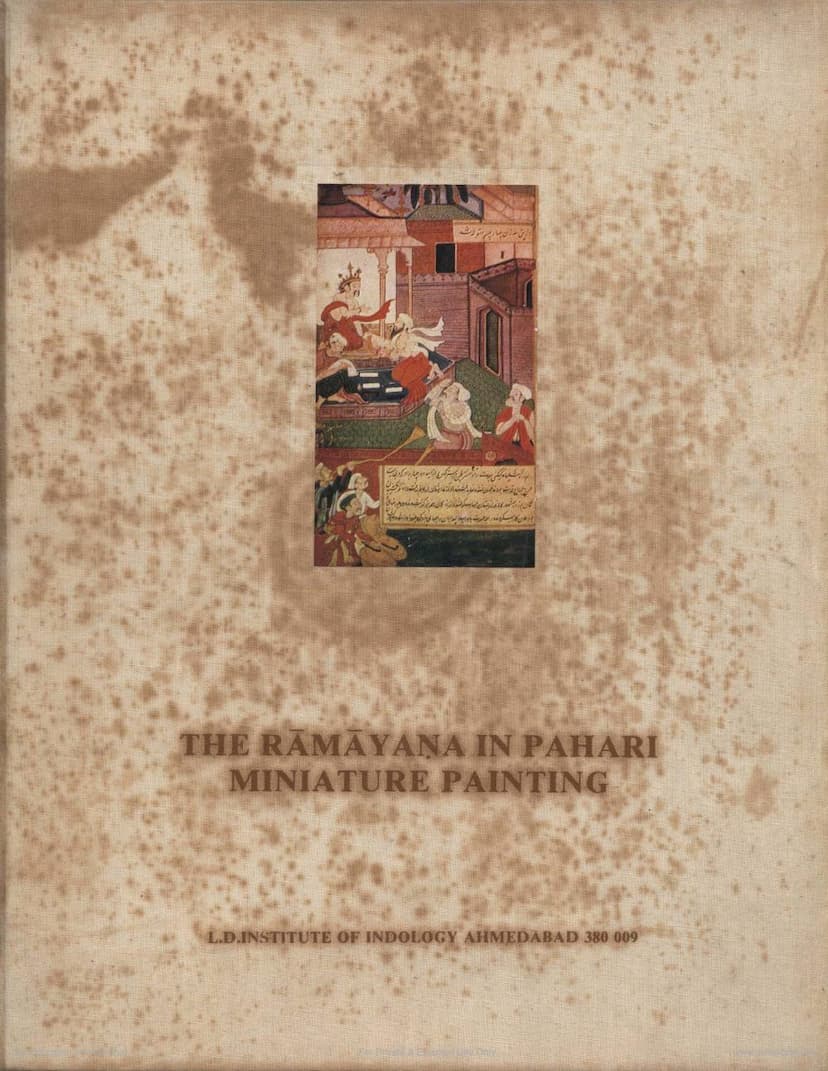Ramayana In Pahari Miniature Painting
Added to library: September 2, 2025

Summary
Here's a comprehensive summary of the Jain text "The Ramayana in Pahari Miniature Painting" by Jutta Jain-Neubauer:
Overall Focus: The book meticulously examines the portrayal of the Ramayana narrative in Pahari miniature paintings, focusing on the stylistic evolution and thematic interpretations within this distinct school of Indian art. It highlights two major series of Ramayana miniatures: one from circa 1720 and the "Siege of Lanka" series.
Key Themes and Content:
-
The Ramayana as a Subject: The book begins by establishing the Ramayana's enduring popularity and its significance as one of India's two great classical epics. It acknowledges Valmiki as the attributed author of the original Sanskrit epic but also notes its evolution through oral traditions and later devotional (Bhakti) renditions. The author emphasizes that Ramayana miniatures, being products of later centuries, often reflect the spirit of personal devotion to Rama.
-
Types of Ramayana Miniatures: The text categorizes Ramayana illustrations into three main types:
- Based on Valmiki's Sanskrit Epic: These are considered part of the "high" Sanskritic tradition, often created under royal patronage by master artists in collaboration with scholars.
- Based on Later Versions: This includes illustrations from vernacular adaptations like Tulsidasa's Ramcharitmanas, Kamban's Ramayana, or Persian translations.
- Illustrations of Local/Folk Versions: These are rooted in oral traditions and might have been created by bards and storytellers themselves, exhibiting a more imaginative and spontaneous style.
-
Pahari Painting Context: The book delves into the broader context of Pahari painting, explaining its origins in the mountainous regions of Northern India, its association with Rajput rule, and its stylistic range. It discusses the different schools within Pahari art (e.g., Basohli, Guler, Kangra) and the theories surrounding its origins, including the potential influence of folk art. The social status of painters and their collaborative work with pandits (scripture scholars) is also highlighted.
-
Religious Background and Rama Worship: The author explores the significant role of Rama worship in some Pahari royal courts, noting its introduction through the Vaisnava Bhakti cult. This worship influenced the iconography of Rama, portraying him as an ideal ruler and divine figure, and consequently, the Ramayana miniatures often served a devotional purpose as well as providing instruction and entertainment. The text also touches upon the syncretism of local beliefs with the introduced Vaisnava cult.
-
Detailed Analysis of Two Key Series:
- The Ramayana Series of ca. 1720: This series is linked to the style of Basohli painting and painter Manaku. It primarily illustrates the Aranyakanda and Sundarakanda of the Ramayana. The book details its horizontal format, distinctive red border, color palette, compositional elements, and iconography, noting its stylistic similarities and differences with the Gita Govinda series. The artist's lineage from Guler is also discussed, suggesting influences between these regions.
- The "Siege of Lanka" Series: This extensive series, generally attributed to the Guler style and dated to circa 1725-1730, focuses on the Yuddhakanda (the "Book of Battle"). The book describes its remarkably large size, the prevalence of unfinished or black-and-white drawings alongside finished miniatures, and its characteristic color scheme and compositional devices. The analysis highlights the detailed rendering of figures, costumes, and the depiction of architectural elements and landscapes. The text also compares it with Mughal miniatures and discusses the possible origins and attributions by scholars like Coomaraswamy, Ghose, and Archer.
-
Stylistic Comparisons and Evolution: A significant portion of the book is dedicated to comparing the two major series, pointing out their shared stylistic features (format, border, color palette, iconography of figures, depiction of animals, landscapes) and also identifying subtle differences that suggest a temporal progression in Pahari painting, moving towards greater naturalism. The influence of Mughal painting is also considered in the development of these Pahari styles.
-
Catalogue of Miniatures: The book includes detailed lists and descriptions of individual leaves belonging to the two discussed Ramayana series, as well as a series from the Museum of Indian Art, West Berlin. This catalogue provides information on their locations, dimensions, and textual content, serving as a crucial reference for art historians and enthusiasts.
In essence, "The Ramayana in Pahari Miniature Painting" is a scholarly exploration that:
- Contextualizes Ramayana illustrations within the broader landscape of Indian art and religious devotion.
- Analyzes two significant Pahari miniature series, detailing their stylistic characteristics, thematic content, and artistic origins.
- Traces the evolution of Pahari painting through these Ramayana depictions, highlighting regional influences and artistic developments.
- Provides a comprehensive visual and descriptive catalogue of the artworks discussed.